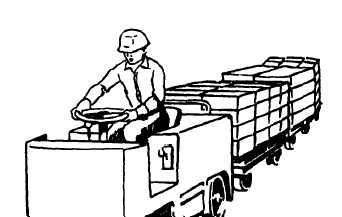| |
TRACTOR-TRAILER TRAINS
The tractor-trailer train (figure 13-2) is a system of
hauling with a self-propelled motor power unit
connected to a series of individual load-carrying
trailers.
Different types of tractors and trailers are used.
Tractor-trailer trains can haul larger loads than
carrier-type trucks of equal horsepower capacity. They
can be operated in trains up to the total drawbar pull of
the tractor. The number of trailers one tractor can keep
in operation depends upon conditions such as length of
haul, nature of material, and weight of the load on each
trailer. Under normal conditions, one tractor should be
able to keep one set of hailers loading, a second set
underway, and a third set unloading. Tractor-trailer
trains may be effectively used on hauls between 400 feet
and 1 mile in length. A carrier-type truck is normally
used for hauls greater than 1 mile.
WAREHOUSE TRACTORS
A warehouse tractor is an electric-or
gasoline-powered vehicle designed to pull a train of
warehouse trailers. The gasoline-powered models most
used in the Navy are equipped with pneumatic tires and
have rated drawbar pulls of 2,600, 4,000, or 7,500
pounds. Electric-powered models are equipped with
solid rubber tires and have rated drawbar pulls of 2,000
or 4,000 pounds. Drawbar pull, the force that the tractor
can exert in pushing or pulling loads, is merely a means
of indicating tractor capability. The actual capacity of
the tractor is normally far in excess of the drawbar pull
rating. A tractor with a drawbar pull of 2,600 pounds
Figure 13-2.—Tractor-trailer train
may, for example, have an actual towing capacity of 50
tons. These are five different models of tractors that are
standard for the military services.
WAREHOUSE TRAILERS
A warehouse trailer is a load-carrying platform
mounted on casters or wheels. Standard trailers are
available in a wide variety of sizes and capacities. Some
are equipped with solid rubber or pneumatic tires. The
caster-steering type has fixed rear wheels that carry
about two-thirds of the load, and caster wheels at the
front through which steering is accomplished. The
caster-steering type of trailer is produced in 4,000 and
6,000-pound capacities.
HAND TRUCKS
Handtrucks may be constructed of wood or metal.
They are used in phases that mechanical equipment
cannot be operated because of space limitations,
The four-wheel platform handtruck (figure 13-3)
may be used to advantage in breaking out retail issues
for bins, carrying light loads, or for any operation
involving short hauls with frequent stops. It may also
be used in multistory warehouses and for small-lot
stockpicking. The truck may be equipped with solid
rubber tires or steel wheels.
The two-wheel handtruck (figure 13-4) consists of
two handles a platform on which the load rests, and
wheels attached to the bottom of the framework. A
blade extends at an angle from the bottom of the
platform to hold the bad.
A stockpicker truck (figure 13-5) is a handtruck
used for picking stock from shelves when filling orders.
The Storekeeper pushes the truck in the aisles between
the shelves to carry small issues in cardboard
containers, paper envelopes, or tote boxes. Some
Figure 13-3.—Handtruck, four-wheel.
13-2
|



